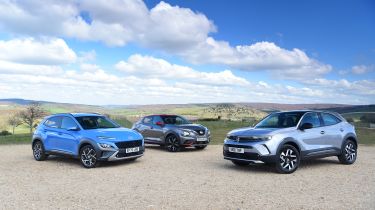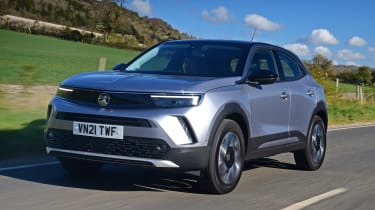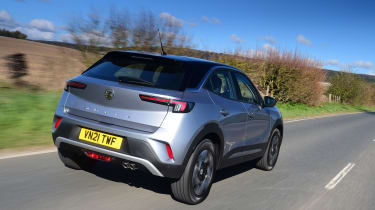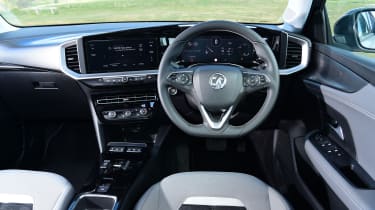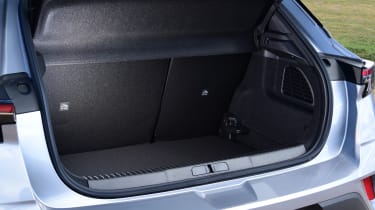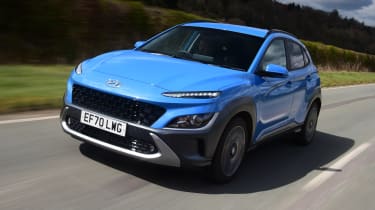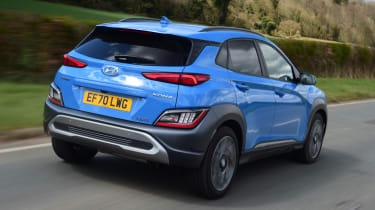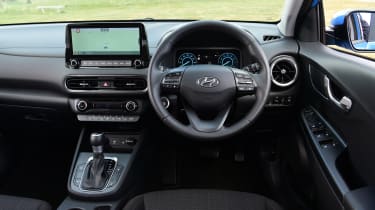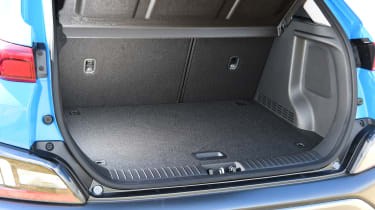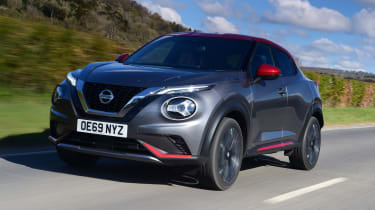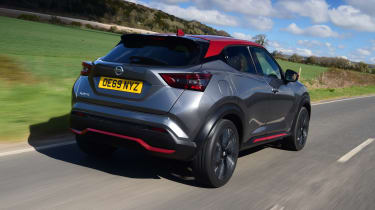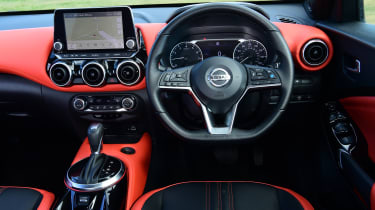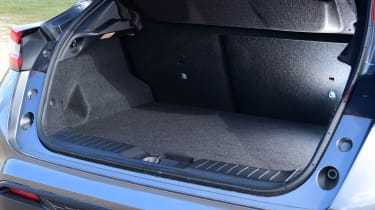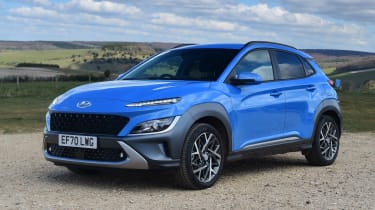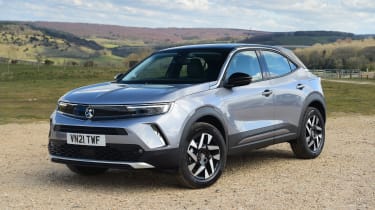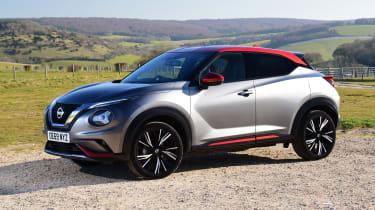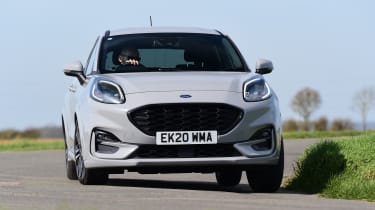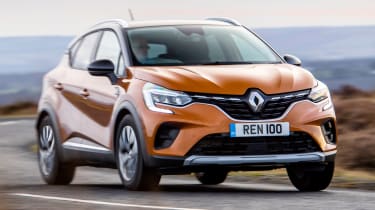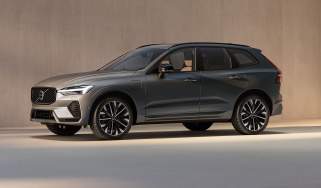Vauxhall Mokka vs Hyundai Kona vs Nissan Juke
Can the all-new Vauxhall Mokka make an impact in the small SUV market? We test it against the Hyundai Kona and Nissan Juke to find out
The original Vauxhall Mokka was very much the prime-time, middle-of-the-road sitcom of the automotive world; it was always incredibly popular, but with so many more interesting, critically acclaimed alternatives out there, it was hard to fathom why.
Now, however, the Mokka has had a reboot. Vauxhall’s compact crossover has been redesigned from the ground up, giving the model a sharp new look in a class where desirability is a key way to win over buyers. But does it now have the substance to back up the style and beat its rivals?
That list of competition is huge, but in the Nissan Juke, the Mokka faces the car that can arguably be credited with both kicking off the supermini-based SUV segment, and making it so popular. Now in its second generation, it still majors on eye-catching looks, which makes it exactly the sort of car that new Mokka buyers might well consider a tempting alternative.
Then there’s the Hyundai Kona. A recent refresh has given the Korean model a more rakish face and improved the technology found inside the cabin.
This, then, is a trio of family cars that stand out from the crowd. As we’ll find out, each crossover has its own unique style, but they’re desperately close when it comes to the final ratings.
Vauxhall Mokka
| Model: | Vauxhall Mokka 1.2 Turbo (130) Elite Nav Premium |
| Price: | £27,100 |
| Engine: | 1.2-litre 3cyl turbo, 128bhp |
| 0-60mph: | 9.2 seconds |
| Test economy: | 38.6mpg/8.5mpl |
| CO2: | 137g/km |
| Annual road tax: | £220 |
The latest Mokka gives buyers a fresh look, new tech and, according to Vauxhall, a more modern driving experience than ever. The brand hopes that a wide range of engine and trim choices will enable the Mokka to secure a large share of the segment. Here we’re driving an Elite Nav model, with a 128bhp 1.2-litre turbo petrol linked to an eight-speed automatic gearbox. Priced at £27,100, it’s the most expensive car here, but not by much.
Used - available now

2021 Vauxhall
Mokka
14,379 milesManualDiesel1.5L
Cash £14,199
2024 Vauxhall
Mokka
14,330 milesAutomaticPetrol1.2L
Cash £17,463
2021 Vauxhall
Mokka
12,971 milesAutomaticPetrol1.2L
Cash £17,087
2024 Vauxhall
Mokka
9,304 milesManualPetrol1.2L
Cash £16,887Design & engineering
Name aside, the latest Vauxhall Mokka shares nothing with its predecessor. While the previous model was conceived under the ownership of Vauxhall’s previous custodian, General Motors, the second-generation car borrows mechanical know-how
from the Stellantis Group, specifically the side formerly known as Groupe PSA before it joined forces with Fiat Chrysler Automobiles.
To this end, the Mokka now rides on the same CMP platform as the Peugeot 2008 and DS 3 Crossback. It shares the same engines, too, with petrol, diesel and fully electric options available.
The petrol engine is a 1.2-litre three-cylinder turbocharged unit; named “PureTech” it’s a motor that has won numerous awards across various applications. In the Vauxhall it produces 128bhp.
Inside, the design of the new Mokka is light years ahead of the previous model’s. It’s helped by the pair of digital displays for the infotainment and instrument panel, but the overall appearance is just far more simple – adorned with only important buttons – and easy to figure out.
The small gear selector on the centre console looks neater than the old-style levers used by the Kona and the Juke, and although the Mokka lacks the colourful appearance of the Nissan’s dash, it feels the most upmarket place to sit. If there’s one criticism about the driving position, it’s that some taller testers found that the steering wheel didn’t have quite enough tilt adjustment to get properly comfortable.
Driving
It only takes a very short distance behind the wheel of the new Mokka to appreciate just how much better it is than the car it replaces. The stodgy, vague feel of the outgoing model has been replaced with something much more positive. While the ride is slightly firmer, the trade-off is a reasonable degree of body control.
There isn’t much to separate this trio, although the Vauxhall edges into a narrow lead, because it feels more responsive than the Kona when driven keenly, and smoother than the Juke when it isn’t. Of course the Mokka’s smaller wheels (17 inches versus the 19-inch items on the Nissan) play a part here, but putting bump absorption to one side, the Vauxhall is also the best model here at isolating the noise of thumps and crashes through the chassis.
The 1.2 turbocharged engine does a great job. Performance is lively enough, and its 230Nm peak torque comes in at just 1,750rpm, so it pulls strongly throughout the rev range. While the three-cylinder unit transmits a little vibration into the cabin under hard acceleration, the motor is not too intrusive otherwise. The eight-speed automatic gearbox is mostly smooth, but its integration with the stop/start system could be smoother.
Practicality
Just getting into the Mokka’s boot is confusing. The release isn’t on the hatch itself, but hidden within the number plate recess below – an area at risk of picking up road grime on a wet day.
The hatch opens to reveal the smallest boot here. The 350-litre volume is a result of a high boot floor, while a false floor neither matches up with the high load lip, nor does it offer a level space because the rear seats don’t fold completely flat. Once they are folded, the 1,105-litre space is again the smallest here.
Back-seat passengers will find that the Mokka is the most compromised for rear legroom, too, but the Vauxhall delivers the most generous rear headroom, although only very slightly more than the Kona. Interior storage is reasonable, aside from a tiny glove compartment that’s crowded by the fusebox.
Ownership
Vauxhall fared poorly in our Driver Power 2020 survey, finishing 29th out of 30 brands. While there’s huge potential for improvement, the fact that fellow Stellantis company Peugeot finished eighth – and the Mokka is mechanically similar to the 2008 – means it’s not hard to imagine that Vauxhall could improve soon.
The good news is that Vauxhall’s customers are more pleased with the dealers than they are with the cars. A 10th-place finish puts it in the top half of 25 brands surveyed; owners were particularly impressed with the standard of work carried out by technicians.
Euro NCAP has yet to assess the Mokka, but the Peugeot 2008 scored four stars in base trim, and a maximum five stars when equipped with all of the active safety systems available.
Running costs
During our time with the Mokka, it averaged 38.6mpg, which means that drivers can expect 374 miles of range between fill-ups and a yearly fuel bill of £2,944. That makes it cheaper than the Nissan to run, but some margin behind the Hyundai.
The Kona is cheaper for company car drivers, too, although the Mokka’s £1,663 Benefit-in-Kind cost for a lower-rate taxpayer is £74 less than the Juke’s, despite the Vauxhall’s stronger performance.
These three cars are separated by just £500 on list price, but the Mokka is set to depreciate the most by some margin. After three years it’s predicted to be worth £12,176 (44.9 per cent retained), while the Hyundai will be worth £14,662 (54.8 per cent), and the Juke comes in at £13,303 (50.01 per cent).
Testers’ notes
“The Mokka adds to a contrasting roof finish with optional red highlights that skirt its edge. SRi versions of the Vauxhall also feature extra red flashes on the alloy wheels.”
Hyundai Kona
| Model: | Hyundai Kona Hybrid 1.6 Gdi Premium |
| Price: | £26,755 |
| Engine: | 1.6-litre 4cyl hybrid, 141bhp |
| 0-60mph: | 8.9 seconds |
| Test economy: | 53.6mpg/11.8mpl |
| CO2: | 114g/km |
| Annual road tax: | £170 |
While the Vauxhall Mokka is the newcomer to the class, this is also the road-test debut of the Hyundai Kona since its mid-life facelift at the start of 2021. The updates introduced revised styling, improved infotainment and a mild-hybrid powertrain. We’re driving the full-hybrid version here, which costs from £26,530 in Premium trim.
Design & engineering
Despite its compact SUV positioning, the Kona’s platform is actually derived from the larger i30 hatchback. Electrification has always been offered to some degree through the range, but now all three powertrains covering the regular Kona line-up feature at least some level of electric assistance.
Things kick off with a 1.0-litre turbocharged petrol engine with mild-hybrid power, which recoups energy under braking to deploy when accelerating, reducing load on the engine. At the other end of the range is the Kona Electric; this offers up to 201bhp from an electric motor, while a 64kWh battery lets it cover a real-world 250 miles between charges.
This hybrid version we’re testing sits between the two. Its 141bhp makes it the most powerful car of our test trio, yet on paper it promises the lowest fuel consumption, too.
Step inside the Kona, and compared with the other two cars, it feels very dreary. Most surfaces are finished in the same shade of grey – including the leather on the steering wheel – while many of the plastics feel hard and scratchy. Even the seat material seems a little cheap compared with that used in the Mokka and the Juke. This puts the brilliant in-car technology into an even starker contrast; we’ll come on to that in the infotainment section.
Driving
Straight away, the Kona’s hybrid system brings its benefits around town. A small 1.6kWh battery and a 43bhp electric motor mean that it can cover short distances in fully electric mode. It’s most noticeable at low speeds, when the Kona will move off smoothly and silently. That’s even more of a benefit in this company, where both rivals are hamstrung by less-than-perfect automatic transmissions.
Unlike its competitors here, the Kona’s 1.6-litre four-cylinder petrol engine doesn’t have a turbo, so it relies on the torque of the electric motor for extra shove. Despite the Hyundai’s stronger peak torque figure of 265Nm, it arrives high up the rev range relative to the Vauxhall and the Nissan, and the Mokka in particular feels more muscular overall.
Against the clock, however, the Kona is the fastest car of this group, with a very reasonable 0-62mph time of 8.9 seconds. The engine doesn’t vibrate like its rival’s small-capacity three-cylinder units, but it sounds the most coarse when revved hard, and the gearbox can be a little rough to engage the next ratio.
The Kona’s ride is certainly on the firmer side of the compact crossover segment. It feels more comfortable than the Juke, but is less well controlled than the Mokka, which means that on rougher roads the Hyundai feels a little less stable. The ride settles down at motorway speeds, though. Otherwise, the priority here is ease of use rather than fun. The steering is light, precise and consistent, and there’s decent cornering grip when called for. Each of these cars has a near-identical turning circle, and a host of external cameras make each similarly easy to park.
Practicality
None of these three models trouble the class best when it comes to practicality, but among this trio the Kona leads the way for passenger space, albeit only just. The Juke shades the Kona’s rear legroom by a matter of millimetres, while overall headroom in the Hyundai is equally close to the Mokka’s, making the Kona the best compromise overall.
It also splits the other two when it comes to load capacity; the Hyundai’s 374-litre boot is down on the Nissan’s, but better than the Vauxhall’s. The Kona’s load bay is the most practical shape, however, thanks to an almost completely level sill leading into the loading area. This remains flat when the rear seats are folded and the full 1,156-litre space is utilised.
Interior storage is on par with the Mokka’s for the most part, but the Hyundai’s rear doorbins are small, and rear-seat passengers have to fight over who gets to use the single USB port.
Ownership
Hyundai scores points over the competition with the best warranty cover of this trio. While not all buyers will own their cars long enough to make the most of the five-year, unlimited-mileage plan, when compared with Nissan and Vauxhall – both of whom offer three year/60,000 mile warranties – it at least implies that Hyundai has confidence in the reliability of its cars.
Based on our readers’ feedback in the Driver Power 2020 survey, Hyundai’s dealer network finished 16th out of 25 dealers. That’s better than Nissan’s network, which came 20th, but Vauxhall’s franchises beat Hyundai’s by coming 10th.
Running costs
In this area, the Kona has a clear advantage. Its hybrid set-up means that fuel bills are significantly lower than with the other two rivals. While neither the Vauxhall or the Nissan got close to 40mpg in the real world, the Kona managed 53.6mpg; this means owners will pay £1,272 a year for petrol to run the Kona.
Despite the advanced electrified technology, the Hyundai slips between the other two for list price.
Lower emissions make it cheaper to tax, too. It sits within the 26-per-cent Benefit-in Kind band, seven per cent lower than the Juke, with company-car drivers paying tax at the lower rate having to shell out £1,380 and £1,737 a year respectively.
Testers’ notes
“Hyundai will soon cater for performance- car fans with the Kona N SUV; it’ll enter the hot crossover fray with 286bhp on tap and offering a top speed of 149mph.”
Nissan Juke
| Model: | Nissan Juke 1.0 DIG-T 114 Tekna + |
| Price: | £26,600 |
| Engine: | 1.0-litre 3cyl turbo, 112bhp |
| 0-60mph: | 11.8 seconds |
| Test economy: | 34.7mpg/7.6mpl |
| CO2: | 145g/km |
| Annual road tax: | £220 |
Since the original Juke hit showrooms a decade ago, roughly 1.5 million have found homes with buyers. Can the second-generation model, which we’re testing here in range-topping Tekna + auto form, priced from £26,600, stand up
to some of the newest challengers in the class?
Design & engineering
The Mk2 Juke was developed under the Renault-Nissan-Mitsubishi alliance, and is mechanically very similar to one of our favourite cars in the class, the Renault Captur. Both ride on the same CMF-B platform, which makes use of high-strength steel in its construction. As a result, the latest Juke weighs roughly 23kg less than the previous model, despite growing in size overall.
While Renault has taken a fairly pragmatic approach to the Captur, focussing primarily on comfort and practicality, Nissan has steered towards the qualities that made the first Juke so popular: unique yet polarising looks and a sporty driving feel.
The only engine offered is a 1.0-litre three cylinder turbocharged petrol unit. It’s available with a choice of either a six-speed manual transmission or a seven-speed dual-clutch automatic gearbox.
Inside, the cabin is both the most interesting to look at here, as well as being the most sporty to sit in. The centre console is high, which makes the driver feel cocooned, the driving position is low, and the steering wheel offers plenty of reach adjustment. Build quality is solid, too, if not outstanding.
Among the Juke’s generous equipment list is Nissan’s Pro-PILOT semi-autonomous driving system. In certain conditions, the Juke is able to accelerate, brake and steer itself, while keeping a safe distance from other traffic.
The latest Juke continues to be built in the UK at Nissan’s Sunderland plant, alongside the Qashqai and the electric Leaf.
Driving
Nissan has fitted the Juke with a firm suspension set-up to give the impression of a sportier feel than the compact crossover norm. Unfortunately, combined with 19-inch wheels on this top-spec Tekna + trim, it results in poor ride comfort.
It’s not just that occupants get jostled over larger bumps and that the driver feels the car fidget over rough surfaces, but also that noise of those shocks isn’t well suppressed between the suspension and the cabin. Neither the Kona nor the Mokka cover themselves in glory when it comes to ironing out an uneven road, but both are quieter while doing so.
Some of this could be forgiven if the Juke traded its comfort for engaging handling, but it doesn’t. Yes, it feels pretty flat through corners, but otherwise it’s numb – the gloopy steering in particular robbing the driver of any enjoyment. Although this won’t be high on most buyers’ list of priorities, the Vauxhall Mokka is more fun to drive, and more comfortable, too. Other rivals like the Ford Puma and Mazda CX-30 are significantly better than the Nissan.
Under the bonnet, the Juke is powered by a 1.0-litre turbocharged three-cylinder petrol engine. With 112bhp, it’s the least potent unit here, which is reflected in an 11.8-second 0-62mph time – 2.6 seconds down on the Mokka and 2.9 behind the Kona. It also can’t match the Vauxhall’s refinement.
The Juke’s auto gearbox isn’t without fault either; the dual-clutch unit engages very suddenly when performing low-speed manoeuvres, causing a frustrating jerkiness when parking or moving off.
Practicality
A generous 422-litre boot volume means the Juke leads the way for storage, thanks to a space that extends deep below the main opening. This height can be raised with a false floor, which sits perfectly level with the rear-seat backs when they’re folded flat. In this layout the Nissan offers an impressive 1,305 litres, which is a full 200 litres more than the Vauxhall.
However, the Juke’s Achilles heel is headroom. There’s significantly less space than in either the Vauxhall or the Hyundai, which is a shame, because kneeroom is the best of the three models. The sloping roof is partly the cause of the headroom issue, while the thick rear pillars and small windows mean that not only might the Nissan feel claustrophobic for children, but the driver’s over-the-shoulder visibility is also compromised.
The Juke’s smartphone cubby is the smallest and the shallowest in the three cars. It means that if you have a device plugged into the USB port – as it must be to use Android Auto – you’re never more than one brisk roundabout encounter away from your phone bungee-jumping into one of the footwells.
Ownership
If a slick, happy dealer interaction is a deal-breaker for you, then the Juke perhaps isn’t the car to go for. Nissan’s franchised network finished a lowly 20th out of 25 manufacturers surveyed in the Driver Power 2020 rankings, with the company’s lowest score coming from the courtesy of its staff.
One area where the Nissan scores very highly is safety, however. When tested by Euro NCAP in 2019, the Juke’s five-star rating included scores of 94 per cent for adult occupant protection and 85 per cent for child occupant protection, which placed it among the safest cars in the class.
Running costs
The Juke proved to be not only the slowest of the three cars on test, but it had the worst fuel economy, too.
An average of 34.7mpg means that the Nissan was almost 20mpg thirstier than the Hyundai Kona, which recorded 53.6mpg in the real world during our test period. That means Juke drivers can expect to pay £1,155 more at the pumps than Kona buyers for every 20,000 miles covered.
Testers’ notes
“High-mounted rear door handles might remind some readers of the Alfa Romeo 156, but Nissan’s Pathfinder used this design flourish first in the late eighties.”
Verdict
First place: Hyundai Kona
The Kona might not be the sharpest-handling car to drive, nor the most stylish inside, but as a sensible crossover buy, the Hyundai makes a very strong case for itself. That hybrid powertrain not only delivers low real-world running costs for both private and company users, but also makes for a smooth and relaxing drive. The in-car tech is great, too. If you’re buying with your head over your heart, then the Kona takes the spoils.
Second place: Vauxhall Mokka
While it narrowly misses out on the win, there are plenty of reasons to recommend the new Mokka over the Kona. It’s more fun to drive, and as long as you’re not too tall, the interior is a nicer place to be. However, it’s hard to ignore the fact that poor residual values bump up monthly costs. Combine that with the Hyundai’s lower fuel bills, and the Vauxhall will be more pricey to run.
Third place: Nissan Juke
The name that started the compact crossover class has since been caught and overtaken by its rivals. The Nissan Juke is still a distinctive car to look at inside and out, the boot is roomy, and the sound system on this model is great. However, for very similar money to its rivals here it lags behind in key areas; the ride is poor, performance and refinement are lacking, and fuel consumption is high.
Also consider...
Ford Puma
- Model: Ford Puma ST-Line X mHEV Auto
- Price: £25,895
- Engine: 1.0-litre 3cyl, 123bhp
Crossover buyers who want to be entertained should look no further than the Ford Puma. But it’s not all about how much fun it is to drive; the Puma is also practical and competitively priced, and its mild-hybrid engine is quite frugal, too.
Renault Captur
- Model: Renault Captur S Edition TCe 140 Auto
- Price: £25,400
- Engine: 1.3-litre 4cyl, 138bhp
The Captur is one of our favourites in this class and it’s easy to see why. Despite sharing the Juke’s underpinnings, the Renault is much better in almost every area. Beside any of its rivals here, the Captur is more spacious, more comfy and cheaper to buy.
Figures
| Hyundai Kona Hybrid 1.6 Gdi Premium | Vauxhall Mokka 1.2 Turbo Auto Elite Nav Premium | Nissan Juke1.0 DIG-T 114 | |
| On the road price/total as tested | £26,755/£27,320 | £27,100/£27,100 | £26,600/£26,600 |
| Residual value (after 3yrs/36,000) | £14,662/54.8% | £12,176/44.9% | £13,303/50% |
| Depreciation | £12,093 | £14,924 | £13,297 |
| Annual tax liability std/higher rate | £1,380/£2,759 | £1,663/£3,326 | £1,737/£3,475 |
| Annual fuel cost (12k/20k miles) | £1,272/£2,120 | £1,767/£2,944 | £1,965/£3,275 |
| Insurance group/quote/VED | 8/£365/£170 | 20/£502/£220 | 13/£399/£220 |
| Cost of 1st/2nd/3rd service | £99/£169/£229 | £160/£265/£305 | £229/£309 |
| Length/wheelbase | 4,205/2,600mm | 4,151/2,561mm | 4,210/2,636mm |
| Height/width | 1,565/1,800mm | 1,531/1,791mm | 1,595/1,800mm |
| Engine | 4cyl in-line/1,580cc | 3cyl in-line/1,199cc | 3cyl in-line/999cc |
| Peak power/revs | 141/5,700 bhp/rpm | 128/5,500 bhp/rpm | 112/5,250 bhp/rpm |
| Peak torque/revs | 265/4,000 Nm/rpm | 230/1,750 Nm/rpm | 200/1,750 Nm/rpm |
| Transmission | 6-speed auto/fwd | 8-speed auto/fwd | 7-speed auto/fwd |
| Fuel tank capacity/spare wheel | 38 litres/repair kit | 44 litres/repair kit | 46 litres/£130 |
| Boot capacity (seats up/down) | 374/1,156 litres | 350/1,105 litres | 422/1,305 litres |
| Kerbweight/payload/towing weight | 1,376/504/1,300kg | 1,200/540/1,200kg | 1,217/376/1,250kg |
| Turning circle | 10.6 metres | 10.4 metres | 10.6 metres |
| Basic warranty (miles)/recovery | 5yrs (unlimited)/5yrs | 3yrs (60,000)/1yr | 3yrs (60,000)/3yrs |
| Driver Power manufacturer/dealer pos. | 13th/16th | 29th/10th | 11th/20th |
| NCAP: Adult/child/ped./assist/stars | 87/85/62/60/5 | N/A | 94/85/81/73/5 |
| 0-62mph/top speed | 8.9 secs/130mph | 9.2 secs/124mph | 11.8 secs/112mph |
| Auto Express econ. (mpg/mpl)/range | 53.6/11.8/448 miles | 38.6/8.5/374 miles | 34.7/7.6/351 miles |
| WLTP combined | 56.5mpg | 47.1mpg | 44.1mpg |
| WLTP combined | 12.4mpl | 10.4mpl | 9.7mpl |
| Actual/claimed CO2/tax bracket | 122/114g/km/26% | 169/137g/km/31% | 188/145g/km/33% |
| Airbags/Isofix/parking sensors/cam. | Six/yes/R/yes | Six/yes/F&R/yes | Six/yes/F&R/yes |
| Auto box/lane keep/blindspot/AEB | Yes/yes/yes/yes | Yes/yes/yes/yes | Yes/yes/yes/yes |
| Clim./cruise ctrl/leather/heated seats | Yes/yes/no/no | Yes/yes/no/yes | Yes/yes/yes/yes |
| Met paint/LEDs/keyless/pwr tailgate | £565/yes/£300/no | £0-£650/yes/yes/no | £0-£170/yes/yes/no |
| Nav/digi dash/DAB/connect services | Yes/yes/yes/yes | Yes/yes/yes/yes | Yes/no/yes/yes |
| Wireless charge/CarPlay/Android Auto | Yes/yes/yes | £150/yes/yes | No/yes/yes |
